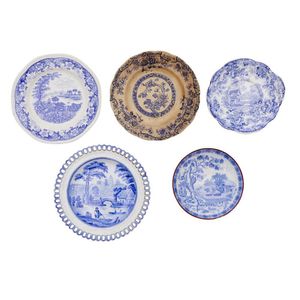Blue and White Transfer Wares, England 1800-30
You must be a subscriber, and be logged in to view price and dealer details.
Subscribe Now to view actual auction price for this item
When you subscribe, you have the option of setting the currency in which to display prices to $Au, $US, $NZ or Stg.
- Chinoiserie - Furniture and decorative items decorated in imitation of a Western interpretation of the Chinese style. The Chinoiserie style first became popular in the late 17th century, though there were frequent revivals, notably by Chippendale (hence 'Chinese Chippendale') during the Regency period, and the Anglo-Japanese style in the second half of the 19th century.
The ubiquitous 'willow pattern' is the most common 'Chinese' theme used in porcelain, while on furniture the Chinoiserie style usually has black or red painted and lacquered decoration, though the hallmark of the furniture style is the use of fretwork in geometrical patterns, pagodas and other decorative forms.
Japonaiseries, as the name implies, are motifs in imitation of the Japanese taste.
See also "Chinese Chippendale". - Transfer Printed / Decorated Transferware - Transfer printing is method of decorating ceramics, reducing the cost of decoration when compared to employing artists to paint each piece. A print was taken on transfer-paper from an engraved copperplate, covered in ink prepared with metallic oxides, and the image on the paper was then applied to the biscuit-fired ceramic body. The print was fixed by heating the object in an oven, and then glazed, sealing the picture. Early transfer prints were blue and white, as cobalt was the only colour to stand firing without blurring. Early in the 19th century advances in the composition of the transfer paper resulted in better definition and detail, and enabled engravers to combine line-engraving with stipple.
- Willow Pattern - Although several potteries including Minton and Spode claim credit for design of the Willow pattern, the design is generally attributed to Thomas Turner of Caughley Porcelain Works in Shropshire, about 1780.
Whilst borrowing from the Chinese style, it was not a copy of a Chinese pattern.
The blue-and-white chinaware on which it appeared became immensely popular and the design was reproduced with variations by many English and European factories including Royal Worcester, Spode, Adams, Wedgwood, Davenport, Clews, Leeds and Swansea.
It was even copied in Asia, where it is still produced, with the wares being exported to Western countries.
The pattern portrays the garden of a rich mandarin whose young daughter elopes with his secretary. The lovers, overtaken on the bridge by her father, are transformed by the gods into birds and flutter beyond his reach. The scene with its willow tree usually covers the central part of a plate, dish, or bowl, with a border of butterflies, a fret, or other motif.
Traditional Willow pattern is in cobalt blue on white, though very occasionally other colours are used, such as purple or brown. The main part of the object contains the trees, houses, bridge, figures, and birds of the story and there is usually a fairly abstract pattern around the extremities.
This item has been included into following indexes:
Visually similar items

Six matching early Staffordshire dinner plates. Blue & white old rose pattern, earthenware c 1820s. one with hairline crack to rim. Provenance: Australian collector. Diameter 25 cm (each)

Three graduated Chinese Qing Dynasty blue and white porcelain plates, all decorated with village scenes, flowers and foliage, a/f, diameter 28 cm, 24 cm, 19 cm, (3)

Four English transfer printed steamship plates, 19th century, the largest 25 cm

A Coalport deep blue and gilt fruit service, comprising an oval and a square plate, two comports and twelve plates, each with a white centre and a deep blue border with raised gilt and a gadrooned gilt edge 23 cm wide.
